Navigating the Dubai Metro Route: An In-Depth Guide
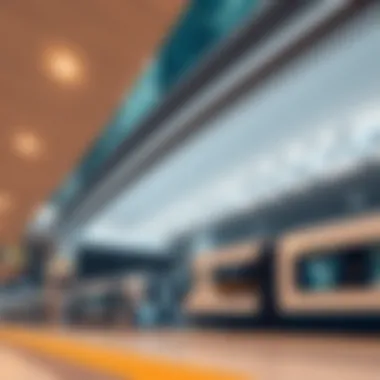
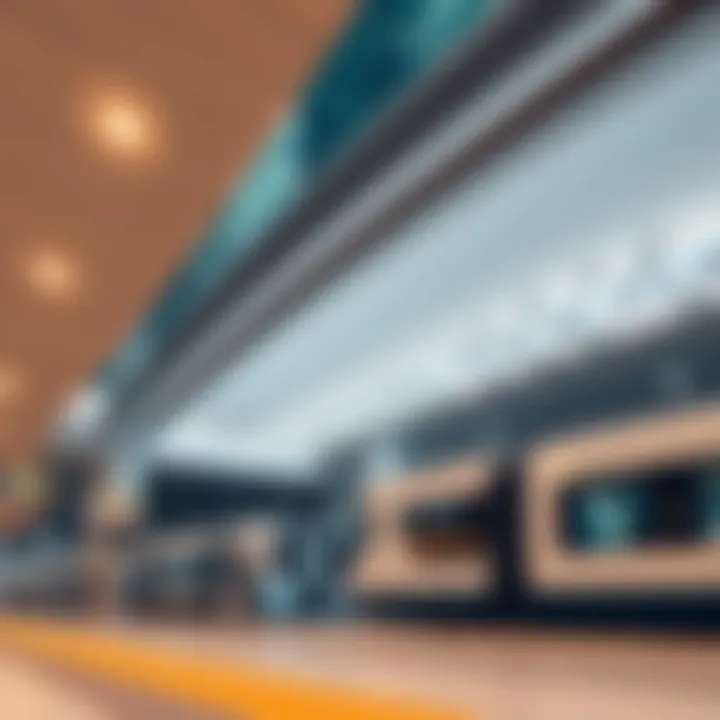
Intro
The Dubai Metro has transformed the way people navigate this sprawling metropolis. With its modern infrastructure and efficient service, the Metro acts as the backbone of the city's public transport. In a city famous for its glitz and glamour, the Metro offers a reliable, affordable mode of transportation. It connects the rich tapestry of neighborhoods, business districts, and leisure hotspots together, facilitating smooth urban mobility.
The impact of the Metro extends beyond just transportation; it plays a crucial role in shaping property trends and urban development. As the city expands, more residents and investors are considering proximity to Metro stations as a vital factor in their real estate decisions. Understanding how the Metro operates and its stations can make a world of difference for those looking to invest in Dubai's booming property market.
In this guide, we delve deep into the various aspects of the Dubai Metro route. We'll examine the lines, the key stations, and the experience of commuting through this state-of-the-art system. Additionally, we’ll explore the implications of the Metro's connectivity on real estate trends and investments, providing insights for professionals and individuals alike.
As we journey through this comprehensive exploration of the Metro, the hope is to illuminate how this public transport play a critical role in not just day-to-day travel but also in shaping the urban landscape of Dubai.
Overview of the Dubai Metro
The Dubai Metro stands out as a pivotal element within the city’s urban mobility framework. It's not just a transport option; it's a lifeline that connects various neighborhoods, commercial hubs, and leisure spots without the fuss of road traffic. For real estate agents, investors, expatriates, homeowners, and developers, understanding the nuances of the Metro can unlock opportunities that might have been overlooked otherwise.
History and Development
The inception of the Dubai Metro dates back to the early 2000s, when the urban landscape was rapidly evolving in response to an influx of residents and tourists. Construction kicked off in 2006, with the first line opening to the public in 2009. This significant infrastructure project underscores Dubai's commitment to becoming a global city, reflecting the aspirations of a burgeoning economy. Over the years, the Metro has expanded, now comprising multiple lines that cover extensive ground – a testament to its vital role in urban infrastructure.
It's interesting to note how the development of the Metro has paralleled the city's journey. These tracks do not merely lay down a transport system; they carry the history of a place that has transformed from a modest trading post to a vibrant metropolis. The precise engineering behind the Metro demonstrates not only architectural prowess but also an understanding of sustainability and efficiency must-haves in an evolving urban environment.
Purpose and Functionality
The primary purpose of the Dubai Metro is to alleviate road congestion while providing convenient access to the city's various attractions. It offers an affordable and reliable means of transport, further enhancing the local economy. With its well-planned stations strategically located near shopping centers, schools, and business districts, the Metro is more than just a means of transport; it integrates seamlessly into the daily lives of those who call Dubai home.
Greater connectivity translates to increased foot traffic in commercial areas, boosting the appeal for potential investors and developers. Also, for residential properties, proximity to a Metro station can significantly impact property values. In fact, studies have shown that homes situated within a one-kilometer radius of Metro stations tend to maintain higher value and offer better rental yields compared to those that are farther away.
In terms of functionality, the Metro operates with a user-friendly ticketing system that accommodates both residents and tourists alike. This ease of use encourages a higher adoption rate, contributing to a reduced carbon footprint and promoting public transport as a viable alternative to personal vehicles.
In essence, the Dubai Metro is key to navigating not just the city streets but also the ever-evolving landscape of urban real estate. Understanding its historical background and functional significance is essential for those looking to invest or establish roots in Dubai.
Metro Lines of Dubai
The metro system in Dubai is not just an essential part of the daily commute for many; it's a vital backbone of the city's transportation network. The Metro Lines of Dubai serve to connect key areas, reduce traffic congestion, and provide a reliable travel method in a rapidly growing urban landscape. By exploring the intricacies of these lines, one gains insight into how Dubai is setting itself apart as a leading urban center.
Red Line
Route Description
The Red Line stands out as the backbone of the Dubai Metro system. Spanning over 52 kilometers, it stretches from the Rashidiya area, close to Dubai International Airport, all the way down to the UAE Exchange Station in Jebel Ali. This line runs through some of Dubai's most famous landmarks, making it a popular choice not just for locals, but also for tourists. The most appealing aspect of the Red Line is its direct access to the bustling downtown area, where attractions such as the Burj Khalifa and Dubai Mall thrive. With numerous trains arriving every few minutes, commuters enjoy a convenient and frequent service, allowing for easy navigation around the city.
Key Stations
Among the key stations along the Red Line, the Burj Khalifa/Dubai Mall Station often takes the spotlight. It serves as a gateway to some of the city's top attractions, drawing both residents and visitors alike. Another important stop is the Deira City Centre Station, which provides access to one of Dubai's prominent shopping malls. The feature that truly sets these stations apart is their proximity to essential services, making it easier for individuals to perform daily errands without needing a car. However, during peak hours, space can feel tight, so planning ahead is crucial for a smoother experience.
Interconnections
Interconnections are a pivotal part of the Red Line’s operation, as they link with several other metro lines and public transport services. The interchange at Union Station, for instance, allows for seamless transfers between the Red Line and the Green Line, facilitating efficient movement across different parts of the city. The advantage here is clear: it enhances the accessibility of the Metro network, making it a reliable option for commuters needing to switch lines quickly. Still, the busy nature of these transfer stations can be overwhelming, especially during rush hours, emphasizing the importance of understanding routes in advance.
Green Line
Route Description
The Green Line adds an essential dimension to the Metro's overall functionality, covering about 22 kilometers. It primarily runs parallel to the Red Line but stretches through areas with a distinctly local feel, from Etisalat Station in Al Qusais to the Creek area. The key characteristic of this line is its focus on connecting residential neighborhoods that are less frequented by tourists, thereby providing a crucial service for locals. Traveling on this line allows passengers to experience a leisurely side of Dubai that's often overshadowed by the bustling tourism of the Red Line.
Key Stations
Noteworthy stations on the Green Line include Al Fahidi and Al Jafiliya, which are situated near cultural and historical attractions. Al Fahidi, in particular, sits close to the Dubai Museum, an added advantage for those looking to immerse themselves in the city's rich heritage. These stations draw a mix of commuters, from schoolchildren to history buffs, making the dynamics of travel varied and interesting.
Interconnections
The Green Line interconnects at Union Station, similar to the Red Line, providing access to other transit forms, such as bus services. This blend of connectivity means passengers can transition from metro to bus systems smoothly. However, travel may require some extra time during busy periods, which is a consideration for those on a tight schedule. Understanding the connections can greatly improve the commuter experience.
Future Expansions
Proposed Lines and Extensions
Looking ahead, Dubai's metro system has ambitious plans for expansion. Proposed lines aim to cover more suburban areas and connect further to the outskirts of the city. One noteworthy project is the Dubai Metro Purple Line, which intends to link major business hubs and improve overall connectivity. This proposed line not only reflects the city's growth ambitions but also aims at reducing road congestion by providing more options for public transport. However, these ambitious plans also entail extensive funding and urban planning challenges that must be navigated to bring them to fruition.
Projected Timelines
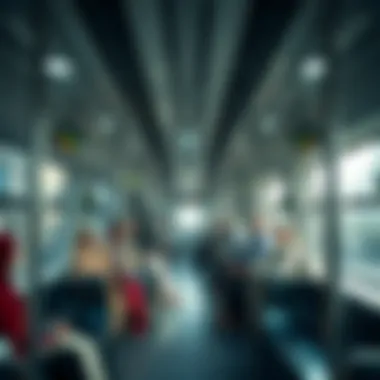

Projected timelines for these expansions are often discussed in the context of Dubai's Vision 2040, a long-term strategy that outlines ambitious aims for urban development. While exact dates can be elusive, the commitment to enhancing the Metro infrastructure is clear. The unique aspect here lies in the city's readiness to invest in sustainable transport, which is a vital aspect of modern urban planning and development. The timeline will not just affect the immediate future of transport in the city but will also shape its long-term urban statistics and patterns.
"Investing in a strong metro system not only addresses current needs but anticipates future growth, making cities more sustainable for generations to come."
Stations and Connectivity
The essence of any metro system lies not only in its operational efficiency but also in the stations themselves. In Dubai, the Metro stations are well-connected hubs that facilitate a seamless commuting experience, drawing in residents, tourists, and business professionals alike. The analysis of Stations and Connectivity addresses how the architectural innovation and strategic placement of these stations bolster the metropolis’s public transport ecosystem. Their importance cannot be overstated as they act as vital junctions for urban movement, guiding passengers from one destination to another while integrating various transport modalities.
Important Transfer Stations
Transfer stations in the Dubai Metro are pivotal as they provide opportunities to switch lines, ensuring that the city is navigable and that commuters reach their destinations without undue complications. Key stations like Union Metro Station and Burjuman Station serve high volumes of passengers daily.
- Union Station connects the Red and Green Lines, making it one of the most congested yet crucial stations in the network. Its strategic location enables easier access to several business districts and attractions such as the Dubai Mall and Al Ghurair Centre.
- Burjuman Station likewise plays a significant role in interconnecting residents and tourists. It links the two main lines and opens the gateway to various shopping experiences, such as the Burjuman Mall.
By utilizing these transfer stations, commuters can optimize their travel efficiency, navigating seamlessly across the city without unnecessary delays.
Accessibility Features
Facilities for Disabled Passengers
The Dubai Metro is designed with inclusivity in mind, making strides to welcome passengers of all abilities. Facilities for disabled passengers include ramps, elevators, accessible restrooms, and auditory signals at train arrivals. This accessibility feature cannot be overlooked as it significantly enhances the commuting experience for those with mobility challenges. Key characteristics such as these make Dubai Metro a popular choice among disabled passengers and add to the overall comfort of the service.
A standout feature is the wheelchair accessibility in all stations. Stations equipped with throughout the Metro allow passengers to board trains without worrying about stairs or steep ramps, aiming for a barrier-free environment. However, some may still find that during peak hours, congestion around the elevators can be a challenge.
Bicycle Storage Options
With a growing emphasis on sustainable transport, the bicycle storage options at certain Metro stations provide cyclists with added convenience and security. These options are essential, as they encourage commuters to opt for environmentally-friendly travel methods, reducing reliance on cars. The key feature here is the availability of designated bike racks at select stations:
- First and foremost, it promotes eco-friendly commuting—a boon for both residents and tourists looking to explore Dubai in a more sustainable manner.
- Moreover, it saves costs and offers the chance to get exercise, which is an appealing factor for many.
While there are facilities available, the challenge lies in ensuring safety and space during peak hours, as there may not always be enough bicycle parking spots for enthusiastic commuters. By addressing both the accessibility and bicycling aspects, the Dubai Metro enhances its role as a linchpin in promoting urban mobility.
Commuting Experience
The commuting experience in the Dubai Metro is a vital aspect of the urban transport narrative, weaving together practicality and comfort for millions of commuters daily. Understanding this experience not only sheds light on how the Metro operates but also highlights its significance to the daily lives of residents and visitors alike. The Metro, designed to ease congestion and provide efficient transportation, has transformed how people move around the city, making commutes smoother and more predictable.
Ticketing System
Types of Fare Cards
The Dubai Metro operates a sophisticated ticketing system, central to facilitating smooth travel across its vast network. There are primarily three types of fare cards: the Red Nol card, the Silver Nol card, and the Gold Nol card. Each serves a unique purpose and appeals to different kinds of users.
- Red Nol Card: This is a one-time use card, generally favored by tourists and occasional riders. It provides a simple option for those who may not plan to use the Metro frequently.
- Silver Nol Card: The most popular choice among regular commuters, this card is rechargeable and offers a discount on fares. It is advantageous for users who travel daily, or several times a week.
- Gold Nol Card: A premium option for those who prefer to travel in the Gold Class, offering luxury seating and less crowded space.
The Silver Nol card stands out as it accommodates a range of travel needs while maintaining affordability. Users can enjoy a balance between convenience and cost, enhancing the overall commuting experience. Additionally, cardholders can easily top-up their cards at kiosks or through mobile applications, streamlining the process.
Pricing Structure
The pricing structure of the Dubai Metro rides stands out for its transparency and straightforwardness. Fares are determined based on the distance of travel, divided into several zones. This structure allows users to pay only for the distance they cover, making it economically sensible.
- Zone System: There are several fare zones within Dubai, which affect the total cost. The greater the distance traveled across multiple zones, the higher the fare.
- Discounts for Nol Card Users: Regular users who pay through Nol cards enjoy a considerable fare reduction compared to those purchasing single journey tickets.
One unique feature of the pricing structure is the provision of fare caps for regular users. This ensures that after a certain number of trips within a defined time frame, additional rides do not result in higher costs. This approach benefits commuters, allowing for better budgeting and savings on their daily transport expenses.
Travel Etiquette
Understanding travel etiquette on the Metro is integral to ensuring a seamless commuting experience. Commuters are urged to respect each other's personal space and to be mindful of the unwritten rules of riding the Metro.
- Queuing: Forming orderly lines while waiting for trains is essential. This not only helos maintain order but also ensures that all passengers board safely.
- Priority Seating: Seats designated for the elderly, pregnant women, and people with disabilities should remain clear for those who need them.
- Mobile Phone Usage: It's considerate to keep phone conversations quiet and utilize headphones for any audio. This courtesy helps maintain a peaceful environment for all passengers.
A little bit of awareness goes a long way in improving the commuting experience, creating a respectful atmosphere aboard the Metro. By practicing good travel etiquette, commuters contribute to a congenial travel atmosphere that benefits everyone.
The Dubai Metro system, with its thoughtful ticketing system, fair pricing structure, and emphasis on etiquette, plays a crucial role in urban mobility. It not only simplifies transportation but also strengthens community living, making life in Dubai a bit more manageable for many.
Effective urban transport is the backbone of a thriving city, and the Dubai Metro exemplifies this by enhancing the quality of daily commutes.
Impact on Urban Development
The introduction of the Dubai Metro has not only transformed the way residents commute but has also significantly reshaped the urban landscape. Understanding its impact on urban development is essential, as it touches on various aspects like residential growth, commercial activities, and overall city planning. The Metro serves as more than just a transit system; it is also a catalyst for economic stimulation, enhancing the connectivity between neighborhoods and business hubs. This interconnectedness drives development, encourages investments, and promotes sustainability, making the Metro a pivotal element in the city’s evolution.

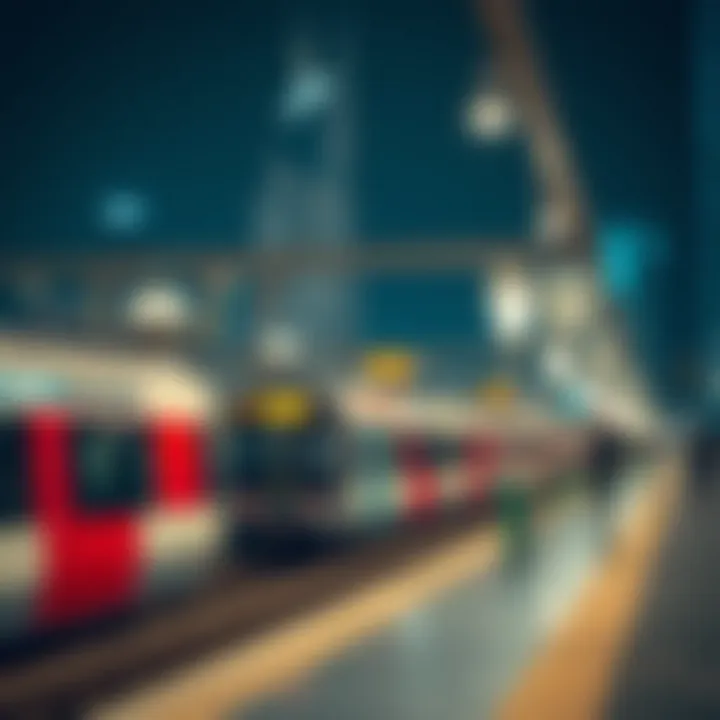
Residential Areas Near Stations
Market Trends
In the realm of real estate, proximity to Metro stations is increasingly seen as a golden ticket by homebuyers. Properties near stations tend to appreciate more rapidly than those that are not, thanks to the convenience of public transport. This has given rise to a noticeable trend: urban dwellers are gravitating towards areas with easy Metro access.
The key characteristic of this trend is how it reflects a shift in preferences, especially among young professionals and expatriates who value time and efficiency. Living near a Metro station offers an appealing lifestyle choice, allowing residents to ditch the long drive and opt for a short ride. While this trend boosts property values, it also brings challenges like increased demand, which can lead to potential housing shortages.
Property Value Implications
The correlation between property values and proximity to the Metro cannot be overstated. Generally speaking, homes located near stations are perceived as more desirable and come with a premium price tag. This is primarily due to the convenience factor; buyers often prioritize accessibility over other features.
A unique feature of this trend is its cyclical nature. As property values rise near Metro stations, developers are incentivized to invest in these areas, further feeding the cycle. However, rising values can also create barriers for first-time buyers trying to enter the market. Thus, while higher property values have their advantages, they can disadvantage certain segments of the population, raising concerns about affordability and diversity in the community.
Commercial Growth
Business Opportunities
The Metro's expansion has opened up myriad business opportunities, transforming the commercial landscape across Dubai. Retailers and entrepreneurs are quickly capitalizing on increased foot traffic near stations. This results in a surge of new businesses catering to Metro users, from cafes to convenience stores, all seeking to make the most of the bustling crowds.
One of the main attractions of these business opportunities is the potential for high customer turnover. Being located near a transportation hub allows businesses to reach a broader audience. However, not all ventures flourish; competition can be fierce, and many newcomers must adapt quickly to the local market dynamics to succeed.
Retail Development
The growth of retail spaces around Metro stations mirrors the evolving needs of urban consumers. Retail development has become increasingly centered on creating vibrant shopping experiences that not only meet basic needs but also provide lifestyle enhancements. For instance, many new projects focus on mixed-use developments that combine residential, office, and retail spaces, maximizing the land's utility.
The distinguishing feature of this retail trend is the emphasis on creating community hubs. Developers aim to design spaces that promote social interaction and engagement among residents and visitors alike. While this enhances the shopping experience, it can also contribute to increased rents, making it essential for city planners to ensure balance between commercial success and community welfare.
In summary, the Dubai Metro's impact on urban development is multifaceted. The interplay between residential growth, commercial opportunities, and retail development not only illustrates how infrastructure can shape a city's landscape but also underscores the importance of strategic planning to accommodate growth while being mindful of community needs.
Environmental Considerations
Understanding the impact of the Dubai Metro system on the environment is crucial. The integration of a mass transit system like the Metro doesn't just cater to the needs of commuters; it also plays a pivotal role in fostering a sustainable urban landscape. In this section, we explore how the Metro reduces traffic congestion, decreases carbon footprints, and the overall perception of the project within the community. The benefits are not merely anecdotal; they represent a tangible change in the dynamics of urban mobility and environmental health.
Sustainability Strategies
Reduction of Traffic Congestion
Reducing traffic congestion is one of the standout characteristics of the Dubai Metro's sustainability strategies. With the city’s rapid growth, the number of vehicles on the roads was becoming an issue. Once the Metro was operational, it significantly eased the burden on the street networks. By providing a reliable, quick alternative to road transport, it encourages people to leave their cars at home.
One unique feature of this reduction in traffic is the way it helps create a more pedestrian-friendly environment. When traffic congestion dwindles, it opens up space for green areas and walkable streets, improving the quality of life for residents. However, there are some challenges. Not every resident adapts readily to using public transport instead of their private vehicles. But as awareness increases and the benefits become evident, more people choose the Metro over driving.
Carbon Footprint Reduction
The Dubai Metro is not just about getting from point A to point B; it also addresses broader environmental concerns. Carbon footprint reduction stands out as a key advantage of this system. Trains produce far fewer emissions per passenger compared to individual cars. Since the Metro operates on electricity, it provides a cleaner alternative, particularly when that electricity comes from renewable sources.
A noteworthy characteristic of this approach is its dual benefit: as the Metro expands, it reduces reliance on fossil fuels. However, the transition is not without hurdles—there’s the significant need for sustainable energy sources to power the trains. Yet, the advantages of cutting greenhouse gas emissions far outweigh potential downsides. The ongoing efforts push cities towards a greener future, and Dubai Metro plays its part successfully.
Public Perception
Surveys and Feedback
The importance of public perception cannot be overlooked. Surveys and feedback from Metro users help gauge satisfaction levels and highlight needed improvements. One key takeaway from these surveys is the general appreciation among commuters for the reliability of the Metro. Many express how it makes their daily commutes simpler and more efficient.
A unique aspect of this feedback loop is its role in shaping future developments and improvements. Authorities often use this information to make informed decisions about service enhancements and station upgrades. Nonetheless, some commuters raise concerns regarding overcrowding during peak hours, an issue that is being addressed gradually as ridership grows.
Community Engagement
Community engagement matters significantly in understanding a transportation system's impact on its users. The Metro’s management has actively sought input from local residents, hosting forums and workshops to foster dialogue. The aim is to create transparency and trust among the users and city planners.
One standout element of community engagement is how it invites residents to envision the future of public transport in Dubai. Pushbacks and endorsements from the community help shape policies and introduce new amenities, including better safety measures and smoother connections. This approach helps ensure that the Metro evolves cohesively with the needs of Dubai’s residents, promoting a collective investment in a greener future.
As we dig deeper into the already profound impact of the Dubai Metro, it becomes clear that its journey is a narrative of innovation interspersed with challenges. Environmental considerations are integral as this dynamic transport system not only reshapes urban mobility but also fosters a greener, more sustainable may of life.
Comparative Analysis with Other Transport Systems
In understanding the impact of the Dubai Metro, it's crucial to explore how it stacks up against other transport systems. This analysis not only highlights the strengths and weaknesses of the Metro but also offers insights into urban mobility trends, regionally and globally. By comparing these systems, stakeholders can better appreciate the benefits offered by the Metro, especially in the realm of real estate and urban planning.
Regional Comparisons
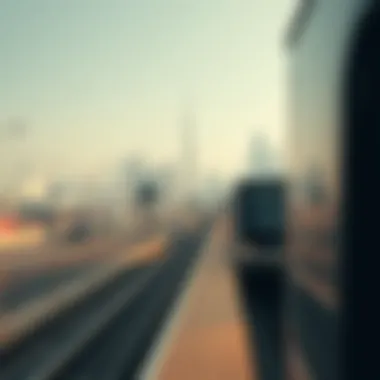
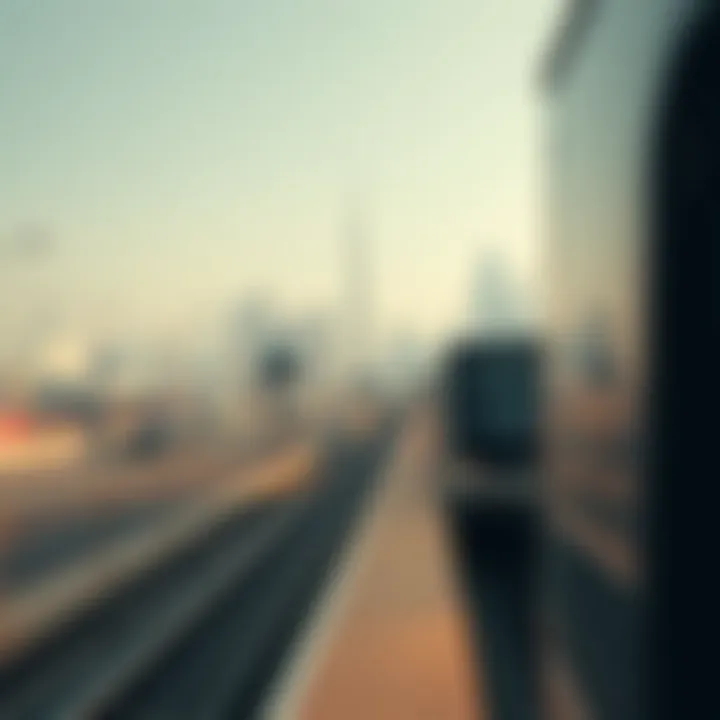
Metro Systems in the GCC
Metro systems across the Gulf Cooperation Council (GCC) present a fascinating study in urban transport solutions. Take, for instance, the Riyadh Metro in Saudi Arabia. One key characteristic of these systems is their recent establishment and rapid development, much like Dubai's own venture into rail transport. They aim not only to provide efficient mobility but also to alleviate congestion on the roads.
The Riyadh Metro has incorporated advanced technologies and design, resulting in a more sustainable transit option. This aligns with Dubai's goal of enhancing its public transport system. Such developments serve as a beneficial model for cities looking to improve their urban transit. However, one must consider the unique feature of Dubai's Metro—its integration into a broader urban framework and lifestyle offerings, like direct access to shopping centers and residential areas.
Thus, while GCC metros provide crucial alternatives, Dubai's offering stands out due to its comprehensive approach, marrying transport with urban living comfortably.
International Models
International models, such as the London Underground or the Tokyo Metro, offer a wealth of comparisons. A significant aspect here is the degree of integration these systems achieve with other forms of transport. The London Underground, for example, acts as an artery connecting various transit modes like buses, trams, and riverboats, creating a seamless travel experience.
The characteristic efficiency of these systems can be invaluable to the Dubai Metro's development. What sets them apart is their historical context and extensive networks, which have evolved over decades. The Tokyo Metro boasts reliability and punctuality, raising the bar for user expectations.
However, a potential disadvantage of these older systems could be their age-related maintenance challenges and crowdedness during peak hours. These issues have been largely avoided in the Dubai Metro's planning, which benefits from modern technology and infrastructure. Therefore, it can be concluded that while international models provide an excellent framework, the fresh approach of the Dubai Metro has its distinct advantages.
Integration with Other Forms of Transport
A well-functioning transport system doesn't just rely on a singular mode but thrives on its integration with various other services. This is particularly evident in Dubai, where the Metro connects effectively with bus and taxi services, enhancing accessibility and utility for users.
Bus Services
Buses in Dubai operate in tandem with the Metro, forming a comprehensive network that expands the reach of public transport. The Dubai Bus system is designed to facilitate easy contact with Metro stops, ensuring that passengers can smoothly transition from one mode to another. A big advantage here is the synchronized timetables, which minimize waiting times.
However, a notable point of consideration is the coverage area. While buses extend service well beyond the Metro, they can be affected by road traffic, which may lead to delays. In this respect, the bus service's efficiency closely intertwines with the urban landscape and road system.
Taxi Services
Taxis in Dubai complement the Metro service, particularly in areas where direct Metro access is not available. The Dubai Taxi Corporation ensures that there are ample taxis available at major Metro stations, providing travelers with flexibility in movement. Their distinctive characteristic is the array of options available, from standard taxis to ride-sharing services.
Yet, taxi usage can be costly compared to public transit, and during peak hours, they may contend with the same traffic issues as bus services. Still, the convenience they offer remains significant for many passengers who prioritize direct routes.
In summary, the integration of bus and taxi services with the Metro creates a holistic transport ecosystem in Dubai. Such a synergy not only boosts commuter experiences but also enhances the overall mobility landscape of the city.
By understanding how the Dubai Metro stands in relation to other systems, we can appreciate its unique contributions to urban infrastructure and urban living.
Future of the Dubai Metro
The discussion around the future of the Dubai Metro intertwines with the city's ambitions to further elevate its status as a global hub. As the urban landscape expands and the population swells, the need for a robust, efficient transit network becomes paramount. The ongoing advancements and strategic plans not only promise enhanced connectivity but also cater to the growing demands of residents and visitors alike.
Technological Advancements
Technological developments are at the heart of the Metro's future, aiming to create a seamless commuting experience.
Automated Systems
One pivotal aspect of automated systems is the implementation of driverless trains. This feature is becoming sought after due to its potential to increase safety and efficiency. With advancements in sensor technology and AI, the train operations can be monitored and controlled with precision. Unlike conventional systems, this automation diminishes human errors, ensuring punctuality and reliability.
A unique characteristic of these automated systems is their ability to integrate with smart city infrastructure. For instance, real-time data can be used to adjust train frequencies based on actual passenger needs, thereby minimizing wait times. However, while these systems enhance operational efficiency, they do require significant initial investment and ongoing maintenance.
Smart Transport Solutions
Moving beyond automation, smart transport solutions encompass a range of innovative integrations, such as mobile ticketing and real-time transit tracking through apps. The key advantage of these solutions lies in their ability to offer passengers convenience and flexibility. Picture this: instead of standing in line to buy a ticket or consulting a timetable, you could book your ride and receive updates on train arrivals right from your phone.
A notable feature of smart solutions is their emphasis on data analytics. By analyzing travel patterns, the Metro can optimize routes and schedules, catering to peak travel times efficiently. Even with such benefits, there’s always the consideration of cybersecurity—how to protect passenger data in an increasingly digitized environment.
Long-Term Vision
The long-term vision for the Dubai Metro, particularly Vision 2040, is ambitious. It reflects a commitment to fostering sustainable urban development while enhancing the mobility of its citizens.
Vision
The Vision 2040 initiative underscores Dubai's aspiration to transform into a model of smart urban development. Central to this vision is a commitment to expand the Metro network by adding new lines and stations, thus making transport options more accessible.
This approach stands out for its focus on sustainability and environmental responsibility. New projects under this vision will adhere to stringent green building codes, promoting eco-friendly commuting options. While such extensive planning can bring long-term benefits, it also poses challenges, especially regarding funding and resource allocation.
Investment Initiatives
Investment initiatives are crucial to the Metro’s expansion plans and future enhancements. Recently, the government has actively pursued foreign investments to fund infrastructural developments. This strategy not only aids in widening the scope of the Metro but also boosts the local economy by attracting international partners.
What sets these initiatives apart is their focus on public-private partnerships. Diverse funding sources can alleviate the financial burden on taxpayers while also accelerating project timelines. However, attracting investors requires demonstrated profitability and public interest, which can be challenging in developing projects.
As the future unfolds, the interplay between technology, visionary planning, and strategic investments promises to shape the evolution of the Dubai Metro into a pivotal element of the city’s transportation landscape.
As we navigate through developments in the Dubai Metro system, the anticipation grows for a transit network that not only meets current demands but also sets the stage for future urban mobility.











